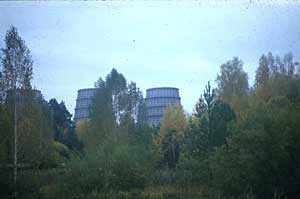
The system built to manage Russia’s nuclear legacy is crumbling, our new report shows
Our op-ed originally appeared in The Moscow Times. For more than three decades, Russia has been burdened with the remains of the Soviet ...
News

Publish date: August 31, 2001
Written by: Rashid Alimov
News
The protocol particularly provides for prolonging the lifespan of three Russian nuclear plutonium breeder reactors, in order to solve the energy supply problems of several towns. According to the governmental decree, reactors ADE-4 and ADE-5 in Seversk, Tomsk region, will be operative till December 31st 2005, and the ADE-2 reactor in Zheleznogorsk, Krasnoyarsk region, will be operative till December 31st 2006.
According to the Russia-US agreement, signed in 1997, breeding of surplus plutonium at these reactors should be terminated in 2002 and 2003 correspondingly. The goal of the agreement is complete termination of weapons-grade Pu breeding at Russian and American industrial reactors.
In compliance with the first Russia-US agreement on Pu-production reactors, signed by then Russian Prime Minister Victor Chernomyrdin and U.S. Vice President Al Gore in June 1994, ADE-2, ADE-4 and ADE-5 were to be shut down by 2000. In 1997 the terms were postponed, and now they are further postponed.
The first proposal in the joint U.S.-Russian discussions was to convert the reactor cores, and fuel them with highly enriched uranium, preventing the spent fuel from containing weapons-grade plutonium after reprocessing. The U.S. Congress authorised $115 million for the conversion project.
The proposal was heavily protested on by the Russian State Nuclear Regulatory, GAN, which claimed that such an alternative would pose a far to high safety risk for the ageing reactors. In 1999 the Russian-American conversion plan failed to attain GANs licence due to safety violations. Moreover, GAN refused to grant a licence for continued operation of these reactors.
In February 2000, Minatom suddenly proposed shutdown of the reactors, admitting that building of fossil fuel would be a more expedient energy supply to the local areas, and an adequate substitute of the reactors.
Later, however, the ministry changed its mind, and made a new proposal to prolong the lifespan of the reactors with 20 years, only modifying their reactor cores for low enriched uranium. To meet some of the GANs criticism, the new proposal included a 20 percent power reduction. Reduced power leads to less heat generating, and therefore less chances of the reactors’ graphite components of deforming.
The reactors are principally similar to the Chernobyl reactor that blew up in 1986, only far older.
The ADE-2, ADE-4 and ADE-5 reactors breed 1,500 kg of Pu per year. That means, that while USA are buying Russian weapons-grade uranium under the HEU-LEU contract to prevent this nuclear substance from getting into terrorists hands and rogue states, and while a new storing facility is being built at the Mayak plant for storing weapons-grade plutonium, Minatom continues to breed this material from the cold war epoch.
Reactors ADE-4 and ADE-5 (reactor facility of the Siberian Group of Chemical Enterprises, SGCE) were put in operation in 1964 and 1965. In 1973, a heat-main from the facility to the city of Tomsk was built, and at present time these reactors provide 30-35% of the heating of Tomsk, and 50% of the heating of Seversk. Present Minatoms plans for conversion of the reactor cores are reported to include that ADE-4 and ADE-5 would be modified in order to work not on the natural uranium, but on the 90% enriched U-235 fuel. That would make breeding of plutonium impossible.
ADE-2 (Krasnoyarsk Mining and Chemical Enterprise, MCE) was put in operation in 1964. It is the main source of heat-supply to the city of Zheleznogorsk. After the state-sponsored defence order was invalidated in 1995, the enterprise had to begin storing plutonium dioxide at its territory in a temporary storage. According to the latest reports, in 2006 Minatom plans to shut down the reactor, and a fossil fuel operated heat power plant is to be completed by the beginning of 2007.
According to RIA News, Minatom representatives said that the problems of energy supplies in Seversk and Zheleznogorsk will be solved in three years.
Yuri Vishnevsky, the head of GAN, said earlier that the ageing Seversk reactors had already twice exceeded their service lifetime, and the safety risks posed by continued operation were rather obvious.

Our op-ed originally appeared in The Moscow Times. For more than three decades, Russia has been burdened with the remains of the Soviet ...

The United Nation’s COP30 global climate negotiations in Belém, Brazil ended this weekend with a watered-down resolution that failed to halt deforest...

For more than a week now — beginning September 23 — the Zaporizhzhia Nuclear Power Plant (ZNPP) has remained disconnected from Ukraine’s national pow...

Bellona has taken part in preparing the The World Nuclear Industry Status Report 2025 and will participate in the report’s global launch in Rome on September 22nd.